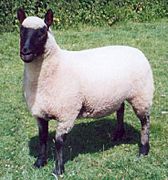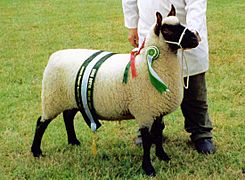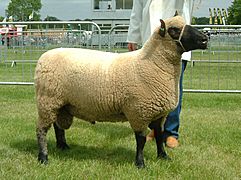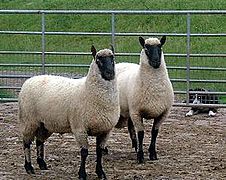Clun Forest sheep facts for kids
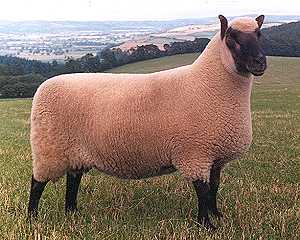
Ram of the Clun Forest breed
|
|
| Conservation status |
|
|---|---|
| Country of origin | England |
| Use | Meat, Milk, Wool |
| Traits | |
| Wool color | White |
| Face color | Dark brown |
| Horn status | Not horned |
|
|
The Clun Forest is a type of domestic sheep. It comes from the area around the Clun Forest in Shropshire, England. These sheep are very tough and can live a long time. They are also good at finding their own food.
Clun Forest ewes (female sheep) have sleek heads and wide hips. This makes it easy for them to give birth to lambs. The breed has wool that is short to medium in length. Their faces are a dark brown color.
These sheep are useful for many things. People raise them for their meat, wool, and milk. Their wool is special because it does not have black fibers. This makes it great for handspinning. Clun Forest sheep are popular with both small and large farms. This is because they are hardy and have many lambs.
Contents
History of the Clun Forest Sheep
The Clun Forest sheep gets its name from the old town of Clun. This town is in the southwest part of Shropshire, England. The surrounding forests also gave the sheep their name.
One of the first times these sheep were mentioned was in 1803. A writer named Rev. Joseph Plymley talked about them. He said that the sheep on the hills near Wales had white faces and no horns.
In 1837, another writer named Youatt confirmed this. He said Clun Forest sheep were white-faced and hornless. But he also noted that the breed was changing. This was because they were being mixed with other local sheep. These included the Longmynd, Radnor, and Shropshire breeds. This mixing led to the darker faces we see today.
In 1892, W.J. Malden described the Clun ram. He called it an "imposing animal." He said it was admired by anyone who knew about sheep.
In 1925, the Clun Forest Sheep Breeders Society was started in Great Britain. Their goal was to keep the breed pure. They also wanted to show how good the sheep were. After World War II, the Clun Forest sheep became very popular. It was the third most common purebred sheep in Britain.
During the 1950s, many Clun sheep were sold. Some farms had very large flocks. Clun sheep were sent to farms all over England. They also went to Scotland and Ireland.
Clun Forest sheep first came to North America in 1970. Tony Turner brought two rams and 39 ewes to Nova Scotia. More sheep were imported later. In 1974, the North American Clun Forest Association was formed. Today, it is harder to import live sheep. But semen from top rams has been brought in.
In recent years, the number of Clun Forest sheep in Britain has gone down. But more people are becoming interested in them in North America. They are also growing in popularity in the Netherlands and the Czech Republic.
What Makes Clun Forest Sheep Special?
The Clun Forest sheep is a medium-sized sheep. It has a dark face. These sheep are known for being tough and living a long time. They are also very fertile and good mothers.
A Clun ewe often gives birth to twins. These lambs grow very fast. This is because the mother's milk has a lot of butterfat.
The face is a key feature of the Clun. It is a rich, dark color and quite narrow. There is no wool on the face, except for a small tuft on top of the head. Their ears stand up straight. This gives them a very alert look.
Clun sheep have a strong, muscular neck. They also have a long, broad back. Their legs below the hock (knee-like joint) should have as little wool as possible. The wool itself should be even in length and color. It should also have a consistent texture.
Meat Quality
Clun Forest sheep are great for farms that raise animals on grass. Their lambs can reach a good market weight quickly. They often weigh about 100 pounds (45 kg) at seven to eight months old. This happens just by eating grass. The meat from Clun sheep is lean and has a mild flavor.
Wool Quality
Clun Forest sheep produce a good amount of wool. Each fleece weighs about six to eight pounds. The wool fibers are about four inches long. The wool is very consistent from the neck to the tail.
Clun fleeces do not have any black or coarse fibers. This makes them good for spinning into yarn. They have an average spinning count of 58.
Milk Quality
Clun Forest ewes produce milk with a very high butterfat content. Because of this, they are often crossed with dairy sheep. Breeds like the East Friesian are used. This helps to make sheep cheeses richer. It also provides larger lambs for dairy farms to sell.
Gallery




